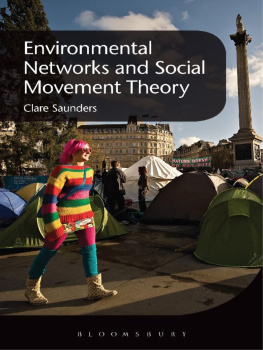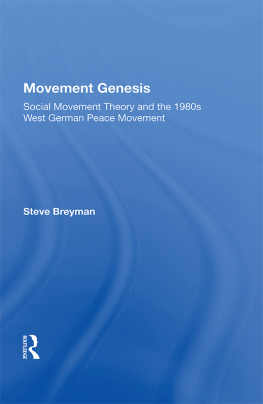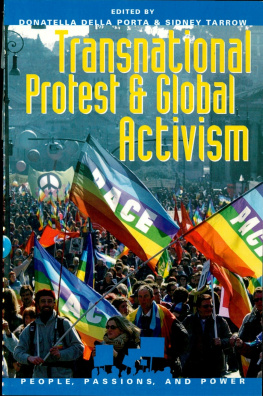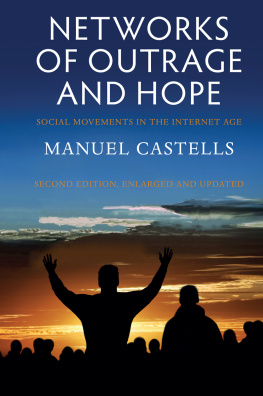Environmental Networks and Social Movement Theory
Clare Saunders
BLOOMSBURY ACADEMIC
An imprint of Bloomsbury Publishing Plc
50 Bedford Square London WC1B 3DP UK
175 Fifth Avenue New York NY 10010 USA
www.bloomsbury.com
First published 2013
Clare Saunders, 2013
This work is published subject to a Creative Commons Attribution Non-Commercial Licence. You may share this work for non-commercial purposes only, provided you give attribution to the copyright holder and the publisher. For permission to publish commercial versions please contact Bloomsbury Academic.
Clare Saunders has asserted her right under the Copyright, Designs and Patents Act, 1988, to be identified as Author of this work.
No responsibility for loss caused to any individual or organization acting on or refraining from action as a result of the material in this publication can be accepted by Bloomsbury Academic or the author.
British Library Cataloguing-in-Publication Data
A catalogue record for this book is available from the British Library.
ISBN: 978-1-8496-6053-2
Library of Congress Cataloging-in-Publication Data
A catalog record for this book is available from the Library of Congress.
I dedicate this book to all the good people who are
working hard to protect Mother Earth.
Contents
T his book would not have happened without the support of many people to whom I am very grateful. Thanks to Graham Smith who sparked my interest in environmental politics. He also carefully read more than one draft and offered comments that have immensely improved the book. Christopher Rootes, Christopher Pickvance, Brian Doherty, Stephan Price, Silke Roth and David Owen have each helped shape my work. Thanks also to Cristiana Olcese for keeping the Caught in the Act project work ticking along while Ive been preoccupied with this book project. Sociological Research Online and the British Journal of Sociology have allowed me to reproduce versions of papers that have been published in their journals ( [Saunders 2008]). Special thanks to Caroline Wintersgill from Bloomsbury for commissioning this book, and for her patience for the final manuscript.
My nearest and dearest also deserve their fair share of accolades. Special thanks to my dear husband, Ian, who has taken more than his fair share of turns at cleaning out our pet rabbits hutches to buy me time to finish this book. Those cups of tea delivered to my desk on rainy days when he has been unable to go out and do his gardening work are worth more than he can know. Thanks also to my family, particularly to Mum who inspired me by repeating (countless times), Have you finished that book yet? Come on, Clare!
I am very grateful for the opportunity to have been a part of the late Local Groups Department at Friends of the Earth (now the Capacity Building Team), the Environmental Direct Action Group, and Chiswick Wildlife Group. Participation in these groups allowed me to develop, first-hand, a broad understanding of different types of environmental action.
This book is based on research conducted throughout my academic career, but which began during my time as a Research Assistant on an EC Framework Programme 7 project called the Transformation of Environmental Activism (ENV4-CT97_0514), directed by Christopher Rootes. I extended this research with my PhD thesis, Collaboration, Competition and Conflict: Social movement and interaction dynamics in Londons environmental movement, which was funded by the Economic and Social Research Council (award number R42200134447). I thank the ESRC for funding my doctoral research.
L ONDON, 1 APRIL 2009. Fossil Fools Day. On this day activists from a number of different environmental and social justice organizations took to the streets for two days of action to call an end to climate chaos, economic meltdown and repossessions. These actions were planned to coincide with a meeting of the leaders of the worlds 20 richest countries: the G20. Their meeting was designed to negotiate a rescue package for the flailing world economy. There were three main protest actions, organized by different wings of what has been termed the environmental movement. The Campaign Against Climate Change, armed with a rapidly melting iceberg (a large chunk of ice), held a climate emergency demonstration and rally at the Excel Centre; around 4,000 Climate Campers pitched tents outside the Climate Exchange and shut it down; and there was a G20 Meltdown street party outside the Bank of England.
After much deliberation, my husband and I decided that the Campaign Against Climate Changes legally approved demonstration outside the Excel Centre was the most approachable; it would, we believed, land us in the least trouble. Since it was billed to last from 12.30 p.m. to 7.30 p.m., we were disappointed to find only around 40 people there for the lunchtime photo opportunity, with numbers dwindling rapidly to single figures by 2 p.m. Although there was a small rally in the evening, it seemed fruitless to wait all afternoon so we set off to visit the Climate Camp. But, before we had returned to the train station, we were stopped by police officers and searched under terrorism legislation on suspicion of intent to conduct criminal damage. If the police were behaving like that near a legally approved demonstration, what would they be like in the vicinity of the Climate Camp? Concerned about heavy-handed policing, we were put off from attending other events and returned home, instead.
Our experience in London that day is illustrative of several issues discussed in depth in this book. Why did only around 40 people attend a legal demonstration on what is, arguably, the most important issue facing humanity and all the species with which we share the planet? In particular, where were the Friends of the Earth and Greenpeace supporters? And why did the Climate Camp hold a separate demonstration rather than collaborate with the Campaign Against Climate Change?
Phil Thornhill, coordinator of the Campaign Against Climate Change, responded to the first question stating, Well, this is fairly typical of a Wednesday lunchtime demonstration (personal correspondence, 1 April 2009). However, this could not account for the presence of thousands of people congregating elsewhere in central London at the same point in time. A better explanation, particularly to the second and third questions, stems from the fact that environmental organizations each have different strategies, degrees of reputability with decision-makers, organizational identities and resource constraints. The Campaign Against Climate Changes approach was a media-friendly stunt. Others might interpret it as a form of lobbying attempting to politely persuade the G20 leaders to take climate change seriously. This is part of the Campaign Against Climate Changes broader goal to build a mass movement by attracting wide-ranging public support for demands for strong national climate change legislation and a robust international climate policy framework. In contrast, Climate Campers and G20 Meltdown participants, generally adverse to what they deem ineffectual lobbying, attempted to directly close down the institutions they considered responsible for causing climate change. Unlike the Campaign Against Climate Change and Friends of the Earth, Climate Camp and G20 Meltdown are fluid networks of activists, without formal organizational structures. Consequently, they are immune from some of the constraints faced by formal organizations. Formal organizations have to engage in organizational maintenance; it is necessary for them to maintain their memberships to keep themselves financially afloat and they have responsibilities towards their staff. The need for organizational maintenance is arguably a key reason why Friends of the Earth, conspicuously absent from events on Fossil Fools Day, had instead participated in the Put People First march and rally the previous Saturday. This mainstream and legally authorized demonstration, organized by a coalition of over 100 environmental, social justice and labour organizations was a safer bet for an organization with a reputation to uphold. In the event, around 35,000 people marched against poverty, inequality and the threat of climate chaos. Unlike the Climate Camp and G20 meltdown, the Put People First march was non-confrontational and remained peaceful throughout, leaving Friends of the Earths reputation and public image untarnished.












